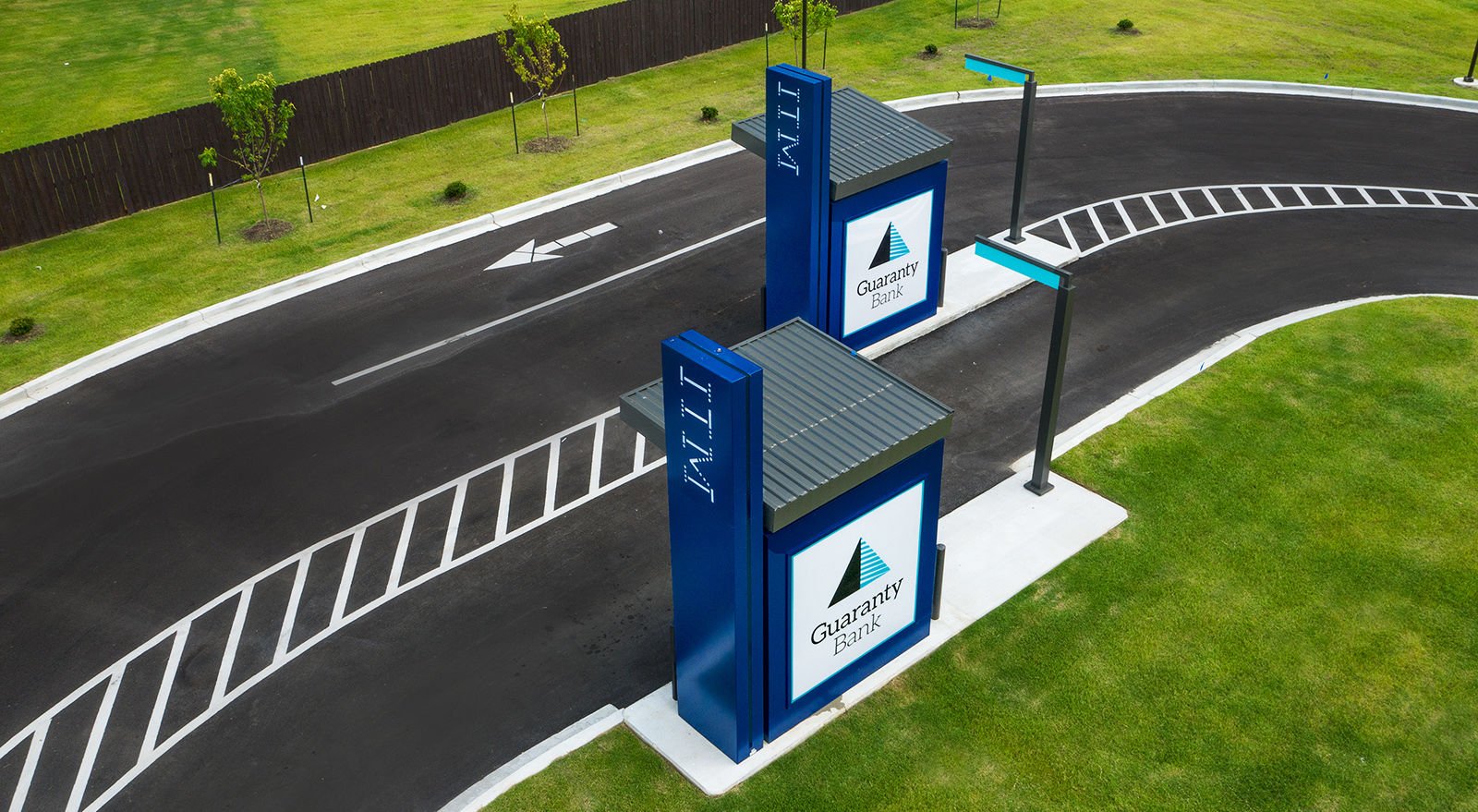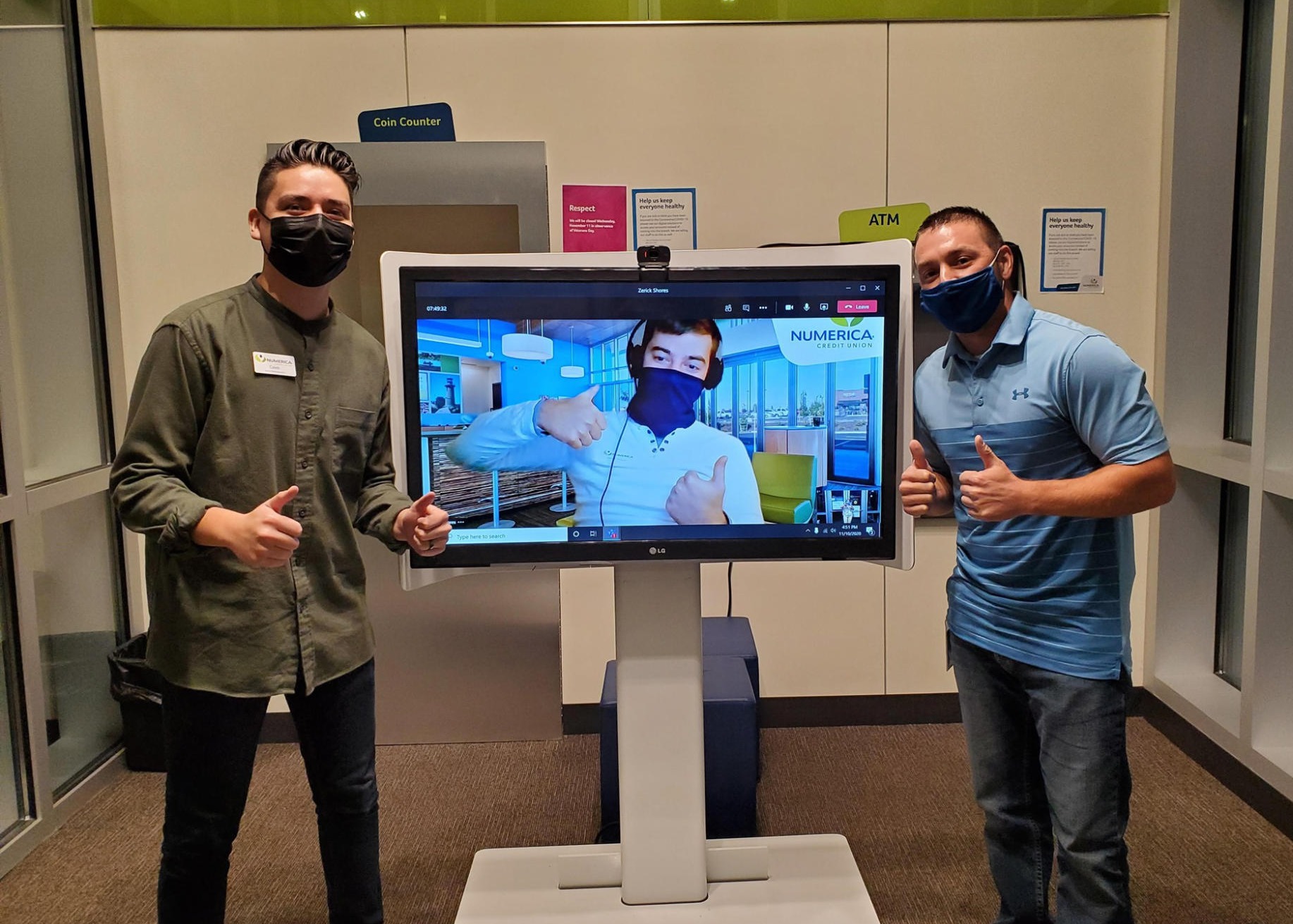 Written by Clara Hori
Written by Clara Horion January 06, 2021
Omnichannel marketing isn’t new but, with COVID, it’s a hot topic again. For financial institutions, having restricted access to lobby branches for the most part of 2020 and probably extending well into 2021 is giving rise to four exciting trends…
(hint, one of them is on wheels....)
Trend 1: Brick-and-mortar branches are transforming - again!
Trend 2: Banks and credit unions are adopting multi-channel attribution
Trend 3: Financial institutions are leveraging predictive personalization
Trend 4: Applied AI is becoming more accessible
 Image credit: Bankia
Image credit: Bankia
Just because 2020 is over doesn’t mean things are back to normal. As this new year begins, the economy as a whole is still navigating the effects of COVID-19. As for the financial services industry, banks and credit unions will continue to deal with lobby access restrictions and the unusual situation of high deposits and high delinquencies, which impacts both interest and non-interest income. A considerable percentage of consumers will continue to experience financial hardship and everyone will still deal with many changes to daily life. As a result, the pandemic has forced financial institutions (FIs) to make some important adjustments in their customer experience strategies.
Financial institutions now must be even more adept at listening to their customers and fine-tuning offerings based on their needs while trying to make the best of existing resources and strengths—like knowledgeable staff and excellent in-branch service. In some cases, banks and credit unions have had to quickly come up with fully digital offerings, while, in other cases, they’ve found a way to adapt traditional practices (such as changing the way customers interact at brick-and-mortar branches).
It’s clear, though, that whatever the strategy, it must include omnichannel marketing. It must integrate all channels, both digital and traditional, into one seamless experience with the customer at the center of it. In other words, you, as a marketer for financial institutions, need to start thinking about retail banking the same way that consumers do.
“Typical banking transactions, car buying, house hunting and simply many in-person meetings have paused for the foreseeable future from the traditional methods. For 2021, we must change our digital search and engagement strategy. In today’s environment, where people are nearly exclusively at the office or working from home, and not traveling or visiting, we must be part of their digital search process ‘where and how’ they are searching and conducting business.”
~ Bruce A. Clapp, President of MarketMatch, a marketing agency specialized in community banks and credit unions.
With lobby access being restricted by COVID, rather than the death of the branch, what we're seeing is its evolution. Studies show that, to create impactful financial experiences, there’s nothing like the human touch. For that reason, and to make effective use of their existing resources, FIs must rely on omnichannel marketing to masterfully blend the convenience and efficiency of digital channels with the warmth and empathy of traditional ones.
In order to build a successful omnichannel marketing strategy for your financial institution, here are four omnichannel marketing trends to expect in 2021.
Trend 1: Brick-and-mortar branches are transforming—again!
Perhaps by a long-shot, the biggest trend we’re seeing is that, rather than completely disappearing, brick-and-mortar branches are adapting to continue meeting the needs of consumers as we remain socially distant.
Despite the growing popularity of online banking and the high spike in usage due to COVID-19, experts predict in-person branches will stay a central part of high-value business. While, for some people, digital works just fine, others (especially from older generations), prefer traditional services. Many FIs, credit unions in particular, feel the call to continue providing services as they have for decades, especially since they have the infrastructure to do so. Besides, there are services that will continue to justify a physical branch visit, like a mortgage or a commercial loan, safety deposit boxes, and medallion certificates.
That said, the pandemic has certainly changed the branch’s role and you must be prepared to venture from “business as usual.” While the branch used to be a leading channel for the vast majority of FI’s with digital channels as a distant second, roles are changing. In some cases, bank branches are evolving into powerful "top-of-funnel" engines that drive brand awareness, educate prospects, cultivate buzz, and generate leads which are then closed by digital channels. For others, branches serve more as a final step in the conversion after customers are introduced by digital channels.
The role of your branch in the customer experience will be just one component of an omnichannel relationship that is amplified by your digital channels. It’s as if branches were star players used to scoring goals on their own and, now, what the team needs to win is for them to turn their energy into becoming great supporters of digital touchpoints.
 Image Credit: Remote Drive-Up Image from "Remote Drive-Up Strategy as a Brand Beacon" on Believe in Banking, powered by Adrenaline.
Image Credit: Remote Drive-Up Image from "Remote Drive-Up Strategy as a Brand Beacon" on Believe in Banking, powered by Adrenaline.
“While consumer demand has certainly shifted digital during the pandemic, what we’re hearing from banks is that their customers still want access to the branch, and data bears that out. The rise in appointment banking and repurposed use of the drive-thru is how the banking industry immediately pivoted to meet the demands of COVID, but these shifts are driving larger industry trends. Not unexpectedly, we are witnessing an evolving role for the branch, moving from transactions to consultations—a shift that was happening pre-pandemic, but even more now—and technologies like ITMs that are bridging the digital-physical divide. Like other industries, COVID is serving as a catalyst, speeding up changes that we were already anticipating in banking.”
~ Gina Bleedorn, Chief Experience Officer from Adrenaline, a marketing agency specialized in community banks and credit unions and Editor-in-Chief and Publisher of Believe in Banking
Here are a few examples of how bank and credit union branches are shifting paradigms to create hybrid experiences that defy categorization.
|
Trend
|
Paradigm shift
|
Examples
|
|
Revival of drive-thru lanes
|
Compared to an open branch lobby and digital channels, drive-thru banking previously lacked advantages. Now we’re seeing a revival of drive-thru lanes as a channel to deliver branch services and a means for a human touchpoint, while still being convenient and efficient.
|
Adrenaline Agency is helping FIs take the drive-thru from a COVID lifeline to beacons of brand, using Starbucks and Chick-fil-A to reimagine what the experience can be.
|
|
Digital self-service
|
Branch services are no longer synonymous with in-person services. Lobbies are becoming a place to also get digital services.
|
Interactive teller machines (ITMs), which look like automatic teller machines (ATMs) but offer way more functionality, are usually supported by video tellers, which are real people working remotely. This makes them more efficient while saving money and space.
|
|
On-site digital training
|
Branches can be an ally in digital adoption by helping those who need a hand with more complicated banking tasks.
|
Training tables and kiosks with in-person staff are available so customers can be onboarded and troubleshoot digital services.
|
|
Providing a human touch, remotely
|
The in-branch “human touch” doesn’t have to mean in-person. It can be provided by an employee working remotely to assist lobby clients as needed.
|
Washington’s Numerica Credit Union virtual greeters
use Microsoft Teams Virtual Conference Manager to guide their customers who visit the bank lobby via teleconferencing.
|
|
Video banking
|
If you want to see and talk to a representative, you no longer have to go to the branch. You can interact with a banker “face-to-face” from the comfort of home.
|
An increasing number of FIs are redeploying bank staff and rolling out video banking to provide a similar level of service, while rationalizing resources.
|
|
Mobile "branch-trucks"
|
Just because it's brick-and-mortar, doesn’t mean it must be fixed in place. Put it on wheels and use it as a backup for city branches with long lines, or follow a scheduled route in rural areas.
|
Branch trucks were already being used in the US to promote the brand and internationally to cover underserved, rural areas. But now, with the restriction of mobility caused by the pandemic, this is a great way to complement digital services while optimizing branch network. In Spain, since the pandemic, Bankia's 11 “branch-trucks” have been driving 25,000+ miles per month to serve 373 rural towns where 250,000 people would not have access to branches otherwise. They not only feature ATMs and tellers for deposits and withdrawals, but also bankers who can open accounts, re-issue debit cards and process loans. Some of them even use clean energy! Check out these recent examples in the Chicago area, Chile (a double decker bus!) and Uruguay.
|
|
QR Codes as CTAs
|
Branches are leveraging their existing real estate (e.g. branch displays, printed materials) to spark interest and generate leads that can be digitally converted. QR codes are a perfect way to capture non-digital leads.
|
Scannable QR codes are being stickered in-branch widows, at drive-thrus, and included in pamphlets to encourage online conversion of all offers.
|
 Image Credit: Adrian, Caleb, and Z from Numerica Credit Union rotating as outside lobby manager; from Numerica's Wenatchee branch
Image Credit: Adrian, Caleb, and Z from Numerica Credit Union rotating as outside lobby manager; from Numerica's Wenatchee branch
The sky’s the limit, really. While the pandemic has certainly complicated matters, it has also created a compelling reason for FIs to innovate and for their clients to try out things that previously seemed impractical or unnecessary in a world where going to a branch was always an alternative.
Trend 2: Banks and credit unions are adopting multi-channel attribution
There have been fantastic innovations in data analysis over the years, but many bank and credit union marketers still struggle to accurately measure their marketing channels’ performance.
For almost half a decade, experts have encouraged financial marketers to improve their marketing attribution models. Back in 2016, a study from Experian was already pointing out that 51% of financial institutions relied on very basic and inaccurate marketing attribution methods. And now, with channels’ roles changing, having a way to measure which channels are driving conversions or ROI is finally becoming a priority for FIs.
“Many businesses believe they are accurately attributing value to their marketing channels, but this is not always the case—rather, they are using out-of-the-box attribution models that rely on arbitrary metrics to assign value,” said Sam Carter, author at bobsguide. “A further limitation of these models lies in the fact that they often underestimate the value of generic keywords, or social channels, in the path to conversion. As a result, marketers struggle to get an adequate budget for these activities—despite the fact they may be leading to customer conversions.”
It’s often impossible to quantify advertising and marketing success when the right attribution practices aren’t put in place. If you aren’t able to accurately credit each specific channel, how are you supposed to explain to your CEO your bank’s marketing successes, failures, and next steps? This is particularly difficult these days since customer journeys span across many different digital platforms.
To counter this, in 2021, we can expect to see “multi-channel attribution,” a standard in other industries, finally being adopted by financial institutions instead of single channel attribution models. In single-channel attribution models, the first or last touchpoint in a customer's purchase (or another relevant action) are credited. But, just because a channel was the first/last touch-point for a customer, it doesn’t mean other channels didn't play a significant role in the process.
Multi-channel attribution considers all of a consumer’s touchpoints and gives relevant credit to each one by using an algorithm based on a statistical model. Analyzing every touchpoint a consumer makes helps you better understand what efforts actually influence revenue and conversions (which is also critical for improving the customer experience). Multi-channel attribution is an important component of an omnichannel marketing strategy, while single-channel attribution models treat each channel as a silo.
Achieving this level of attribution can be tricky, especially if you don't have the right marketing automation tools in place. Reporting results for marketing efforts across different channels, including owned channels like online banking and mobile apps, is a key strength of solutions specifically designed for omnichannel marketing in financial institutions like Prisma Campaigns.
By taking this holistic view of the customer journey, you can avoid having your channels compete against each other and much more accurately optimize, budget, and strategize your marketing efforts.
Trend 3: Financial institutions are leveraging predictive personalization
When the pandemic began, some customers were hit really hard while others were able to continue mostly business as usual. Generic messages alienated customers, while personalized ones generated empathy and engagement that strengthened brands.
Smart FIs were able to use their data to identify who needed what. Consumers in dire need swiftly received the resources and assistance they required, while those who were doing all right appreciated the encouragement to continue working towards their financial goals.
In 2021, we can expect financial institutions to continue leveraging data, AI, and machine learning to not only segment their audiences, but also apply the “Next Best Action” (aka “predictive personalization”). This will allow for real-time financial recommendations and a level of test-and-learn capabilities far beyond what we have previously seen in the industry.
"The return on investment of customer-first, cloud-based Business Intelligence (BI) analytics journeys, linked to smart marketing automation tools and omni-channel content will drive significant return to an organization’s bottom-line performance and growth. But most importantly it will allow financial brands to compete and win at exceeding their customers’ expectations for simpler, personalized experiences."
~ Mark Weber, CEO of Strum Agency, a financial services brand and marketing consultancy and, Strum Platform, a next generation business intelligence solution for FIs.
Currently, 75% of banks and credit unions aren’t leveraging predictive personalization to the level consumers expect, so 2021 will be a year to catch up. As Accenture found, 48% of consumers abandoned a purchase when the experience wasn’t personalized and 91% said they would be more likely to buy from brands that really know them.
To improve this, financial institutions will need to track and leverage data behind consumer behavior across all channels, both online and offline, which, once again, is where an omnichannel marketing strategy comes into play.
As a bank or credit union marketer, you’ll need predictive models to make sense of all this demographic and psychographic data, so you can use it not to sell products, but to build an emotional connection—which in turn is what creates sustainable growth.
“Predictive analytics are the new frontier of highly personalized customer service. From acquisition to onboarding to retention—predictive analytics offer insights into the challenges and opportunities within every stage of the member life cycle. Predictive models look deep within your members’ data to anticipate their needs and deliver just the right solution at exactly the right time.
~Karan Bhalla, CEO of CU Rise, a provider of data science services for credit unions.
Trend 4: Applied AI is becoming more accessible
AI lets consumers find what they’re looking for faster than ever and financial institutions can strongly benefit from the trend. This technology is changing things in every sector of the industry (including front, middle, and back offices) and, in 2021, it will likely become even more accessible. AI is already providing leading customer service software with systems like chatbots and, as it continues to evolve, it will allow for faster transactions, increased convenience, and efficient risk-management at all levels.
This will in part be thanks to more customer touchpoints and increased use of martech. While financial institutions have traditionally only had a few large-scale touchpoints with their customers (for example, branch visits), the trend is shifting to many smaller touchpoints.
In general, banks and financial institutions used to primarily generate passive relationships with customers. For example, they would respond when a customer approached them to open an account or apply for a service. Now, many FIs are beginning to leverage their own channels and third-party sites to approach prospects themselves more often, which is made possible by technology and an omnichannel strategy. This can include leveraging social media, apps, and even SMS to increase visibility and further build consumer trust.
FIs are also starting to meet people in “micro-moments” more often. A micro-moment is when a consumer is looking for an answer (or to buy something) and they instinctively turn to a device (often the smartphone in their hand). In 2021, we can expect financial institutions to use those micro-moments to their advantage. By using AI and automation to provide immediate answers and using predictive analytics to learn consumer habits, financial institutions can better react to their customers’ needs during micro-moments.
Again, this may include chatbots to increase customer engagement by providing quick answers, or it could be pre-approval for loans to help consumers who spontaneously decide to make a big purchase. It can also involve using AI to generate accurate predictions for when consumers are likely to buy a home so they can quickly get answers about their mortgage rates (thus minimizing the desire to take their time looking at competitors).
All of this in mind, it’s critical that you clearly show customers how this new technology will benefit them. You must demonstrate that martech and AI-powered technology results in improved service and not just a way for your financial institution to cut costs. Like many bank and credit union reps, Kelly Ferguson, Chief Administration Officer at Numerica Credit Union, has found that prioritizing a human connection with their customers this year is key.
“This year, one thing has been clear—people are the heart of our credit union,” said Ferguson. “We knew that using technology would enhance the special connection between our members and staff, meet people where they are, and break down barriers.”
The most impactful touch points balance trust and a human element with increased engagement and efficiency. To make the most out of them, you must design them to be simple and fast, yet still personable.
Key takeaways
Consider these trends to start 2021 on the right foot.
2021 will be a year to prioritize your customers’ journey and leverage technology without sacrificing human connections. It will require you to get creative and meet your customers where they are, whether that’s through virtual service in your brick-and-mortar branch, or using AI to meet them across various digital platforms with the right messaging at the right moment.
As you plan your 2021 marketing strategy, keep in mind these questions:
- How could your brick-and-mortar branch adapt to changing usage trends? Are there ways to merge digital with in-person experiences?
- Are you attributing all of your customer touchpoints across channels? Which ones are you not accurately attributing?
- Are you using demographic and psychographic data to send predictive personalized messaging or are you sending generic messaging?
- How can you better leverage AI to increase efficiency without losing out on strong customer service and emotional connections?
We’re still navigating uncharted territory but, by being aware of these trends, you’ll have a major leg up in helping your FI prepare for the shifting atmosphere. A large part of this will include implementing omnichannel campaigns so you can create a smoother, more personalized customer experience.
As the four trends we covered demonstrate, today’s consumers expect a thoroughly connected experience with their bank, no matter where they’re interacting with them—and an omnichannel strategy is key to achieving this. Wherever 2021 takes us, customer loyalty, brand visibility, and improved analytics will be essential to your FI’s success and an omnichannel marketing platform is the perfect place to start improving these things.
Want to learn more about omnichannel marketing?
To learn more about the key benefits of an omnichannel marketing campaign and what it means for financial institutions, check out this blog post.
Additional Reading
- The key to optimizing marketing channels for financial services businesses
- How to achieve multi-touch attribution in a changing financial marketing landscape
- Predicting the future is a strategy not a wish
Image credit: Adobe Stock